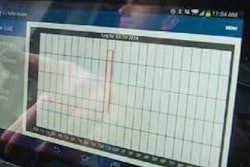The Stifel company’s Transportation and Logistics group recently issued this report to investors, notes from a conference call with a representative of the Transplace 3PL/brokerage about its best estimations of what some have called “the mother of all capacity shortages” upcoming with the FMCSA’s electronic logging device mandate. Overall, the report’s conclusions advised such a big event wasn’t likely to be the huge boon to rates/pricing many have expected/hoped for.
The larger fleets that Transplace has surveyed reported anywhere from a 3 to 6 percent productivity decline with ELDs, Stifel reported, some gaining it back after operational changes were made to adjust, while smaller fleets were speculated to have experienced greater declines, at least some of them.
Eight in every 10 larger fleets (defined in the report as 250 trucks or more) “reported that they had fully implemented ELD’s,” Stifel wrote, while “only 33 percent of smaller fleets had fully implemented.” For owner-operators, Overdrive‘s most recent estimations show an even smaller share having moved to implement a fully engine-connected e-log yet unless they were leased to a fleet where it was required or encouraged. Montana-based owner-operator Chuck Shaffer is one among the latter.
 Chuck Shaffer hauls in a big red 2007 Volvo 780.
Chuck Shaffer hauls in a big red 2007 Volvo 780.If Shaffer’s right, at least in live-load flatbed, the 3-6 percent declines in productivity could be a significant underestimation of the ELD capacity effect.
When it was required in mid-2014 at his leasing fleet, Shaffer moved to e-logs. The subsequent year he took a dramatic revenue hit, he says, to the tune of $20,000 worth of a decline, or between 12 and 15 percent overall. Some of it, however, can be attributed to the dramatic decline in fuel prices at the end of 2014 (fuel surcharge revenue subsequently fell sharply), but a good bit he attributes to e-logs, certainly more than 3-6 percent.
“If $5,000 [of the $20,000 decline] was due to fuel,” he speculates, that would mean about 9-10 percent of the drop was due to another factor in what he says was more or less a pretty good year, with more than enough load opportunities and decent rates. (This year hasn’t been the same, but that’s another story altogether.)
With the e-log new to his operation, however, missed load opportunities abounded, for reasons of hours. And in case anyone is wondering, Shaffer notes he’s “not one that did creative writing in the last 10-15 years. But with the current rules the way they are,” with rigid constraints on hitting the pause button for very long on the 14-hour on-duty clock, moving electronic has firmed up that rigidity, with costly results.
For operators in drop and hook situations, such a fall wouldn’t likely be apparent, or at least less dramatic, he guessed, given they “don’t have to sit a dock waiting to get unloaded,” or spend much time waiting to load.
What’s been your experience when you moved electronic, if you have?
The issue at hand raises a point many owner-operators have long argued: a change allowing greater split-rest-period flexibility to pause that 14-hour clock might help alleviate some of the hours-management issues raised with the current hours rule, enforced with ELDs. We’ll see where recent moves toward such a potential ultimately end up. Read more about the moves to test those waters here:











